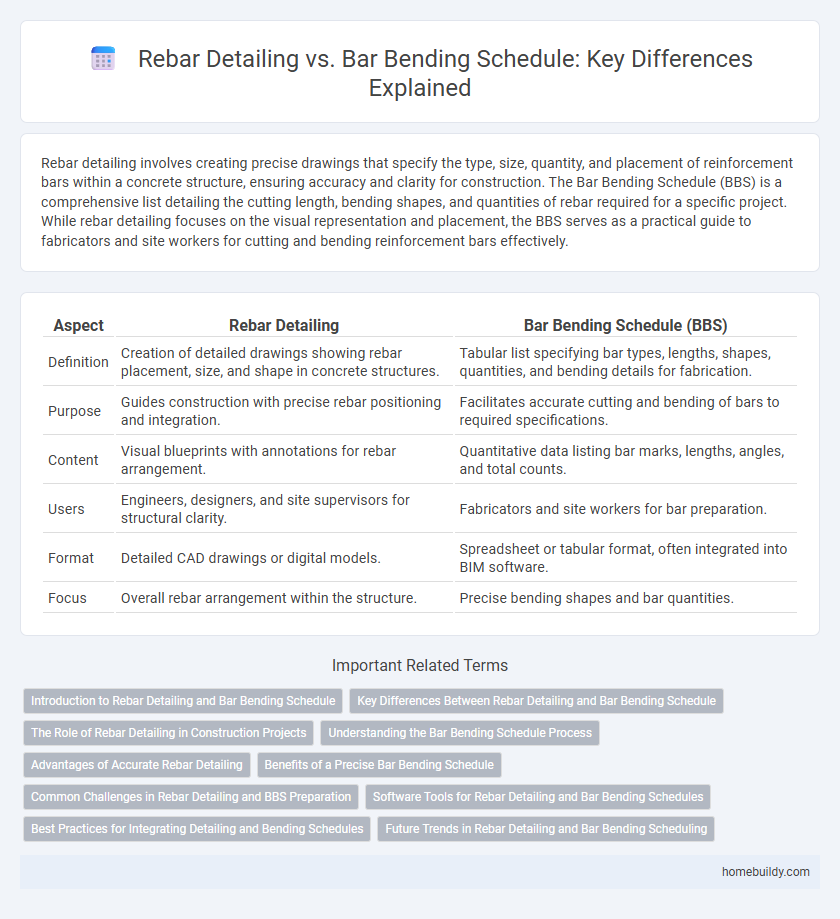Rebar detailing involves creating precise drawings that specify the type, size, quantity, and placement of reinforcement bars within a concrete structure, ensuring accuracy and clarity for construction. The Bar Bending Schedule (BBS) is a comprehensive list detailing the cutting length, bending shapes, and quantities of rebar required for a specific project. While rebar detailing focuses on the visual representation and placement, the BBS serves as a practical guide to fabricators and site workers for cutting and bending reinforcement bars effectively.
Table of Comparison
| Aspect | Rebar Detailing | Bar Bending Schedule (BBS) |
|---|---|---|
| Definition | Creation of detailed drawings showing rebar placement, size, and shape in concrete structures. | Tabular list specifying bar types, lengths, shapes, quantities, and bending details for fabrication. |
| Purpose | Guides construction with precise rebar positioning and integration. | Facilitates accurate cutting and bending of bars to required specifications. |
| Content | Visual blueprints with annotations for rebar arrangement. | Quantitative data listing bar marks, lengths, angles, and total counts. |
| Users | Engineers, designers, and site supervisors for structural clarity. | Fabricators and site workers for bar preparation. |
| Format | Detailed CAD drawings or digital models. | Spreadsheet or tabular format, often integrated into BIM software. |
| Focus | Overall rebar arrangement within the structure. | Precise bending shapes and bar quantities. |
Introduction to Rebar Detailing and Bar Bending Schedule
Rebar detailing involves creating precise drawings that specify the size, shape, quantity, and placement of reinforcement bars in concrete structures, ensuring accurate fabrication and installation. A Bar Bending Schedule (BBS) is a comprehensive tabulation listing all rebars with their lengths, bending shapes, and quantities, serving as a critical reference for cutting and bending operations on-site. Both rebar detailing and BBS are essential for optimizing material usage, reducing waste, and enhancing construction accuracy in reinforced concrete projects.
Key Differences Between Rebar Detailing and Bar Bending Schedule
Rebar detailing involves creating detailed drawings that specify the size, shape, location, and quantity of reinforcement bars for concrete structures, ensuring accurate placement during construction. Bar Bending Schedule (BBS) is a comprehensive spreadsheet or list that quantifies the types, lengths, bending details, and quantities of reinforcement bars required, facilitating precise cutting and bending. Key differences include rebar detailing emphasizing graphical representation and spatial coordination, while BBS focuses on detailed numerical data for procurement and fabrication.
The Role of Rebar Detailing in Construction Projects
Rebar detailing ensures precise representation of steel reinforcement, providing accurate drawings that facilitate efficient fabrication and placement on-site. It bridges the gap between design and construction by delivering comprehensive information on bar sizes, shapes, lengths, and bending angles, reducing errors and rework. This detailed documentation optimizes resource allocation and reinforces structural integrity throughout construction projects.
Understanding the Bar Bending Schedule Process
The Bar Bending Schedule (BBS) process involves creating a detailed list that specifies the types, quantities, lengths, and bending shapes of rebars required for a construction project, ensuring precise material estimation and cutting. Unlike rebar detailing, which focuses on the graphical representation of reinforcement placement, the BBS emphasizes accurate rebar fabrication instructions to optimize resource use and minimize wastage. Understanding the Bar Bending Schedule process is essential for coordinating with fabricators and site workers to maintain structural integrity and project timelines.
Advantages of Accurate Rebar Detailing
Accurate rebar detailing ensures precise placement and alignment of reinforcement bars, reducing construction errors and material wastage. Detailed drawings facilitate efficient communication among engineers, fabricators, and contractors, improving project coordination and timelines. This accuracy enhances structural integrity and compliance with design specifications, ultimately leading to cost savings and safer buildings.
Benefits of a Precise Bar Bending Schedule
A precise Bar Bending Schedule (BBS) enhances construction efficiency by providing accurate bending lengths, shapes, and quantities of rebars, significantly reducing material wastage and labor costs. Detailed BBS facilitates seamless coordination among engineers, contractors, and fabricators, minimizing delays and errors during the reinforcement installation process. Optimizing rebar usage through BBS leads to improved structural integrity and compliance with design specifications, ensuring safer and more cost-effective construction projects.
Common Challenges in Rebar Detailing and BBS Preparation
Rebar detailing and Bar Bending Schedule (BBS) preparation face common challenges such as accuracy in measurement, ensuring proper bending shapes, and coordination with structural design specifications. Inaccurate rebar detailing can lead to misinterpretation in BBS, causing delays and material wastage. Effective communication between engineers and fabricators is critical to prevent discrepancies and maintain construction quality.
Software Tools for Rebar Detailing and Bar Bending Schedules
Software tools for rebar detailing such as AutoCAD Revit and Tekla Structures enable precise modeling and visualization of reinforcement layouts, improving accuracy and reducing errors. Bar bending schedule software like Bar Bending Schedule (BBS) Maker and RebarCAD automates the calculation, quantity estimation, and presentation of rebar cutting and bending data, streamlining project management. Integration between detailing and BBS software enhances coordination between design and fabrication teams, optimizing construction workflows and material utilization.
Best Practices for Integrating Detailing and Bending Schedules
Integrating rebar detailing with bar bending schedules enhances construction accuracy and reduces material wastage by aligning design specifications with fabrication processes. Utilizing software platforms like AutoCAD Rebar and Tekla Structures allows seamless data exchange, ensuring that detailing drawings accurately reflect bending schedules for precise fabrication. Establishing standardized protocols for updating and cross-referencing these documents ensures consistency and facilitates efficient communication between design and construction teams.
Future Trends in Rebar Detailing and Bar Bending Scheduling
Future trends in rebar detailing and bar bending scheduling emphasize automation and integration with BIM (Building Information Modeling) technology, enhancing precision and real-time updates. Advanced software solutions incorporate AI-driven clash detection and optimized material usage, reducing waste and project costs. Cloud-based platforms enable seamless collaboration across engineering, fabrication, and construction teams, accelerating project delivery and improving workflow efficiency.
Rebar Detailing vs Bar Bending Schedule Infographic

 homebuildy.com
homebuildy.com